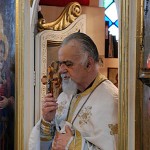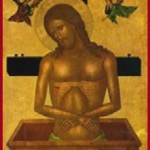Orthodoxy and Peace. Rightly, the beginning of this chapter deals with the liturgical aspect of peace. Even though it is not always emphasized, this should be the crux of any discussion of the theology of the Church. I once read a statement from a well known Orthodox theologian who endured the Communist repression of the Church in the last century. He said that Church was striped of all her riches, schools, and influence; as long as the Liturgy was served, the Church would survive. This was the reality of persecuted Orthodoxy; liturgy is the heart of the Church and fed the soul of the faithful. Behr-Sigel chose to begin her essay with this observation. She points out the central place of peace within the Divine Liturgy. The deacon begins the Great Litany asking that “peace” be the entire bearing of the participants in the liturgy.
[caption id="attachment_313" align="alignleft" width="150" caption="Peace Unto All"] [/caption]
The priest blesses and calls for “peace for the congregants and they respond asking for his spirit to be peaceful. Clergy exchange the Kiss of Peace. With the exception of the personal pronouns “we and us,” peace is the single most often used word in our liturgy. After focusing on the centrality of peace in the liturgy, Elisabeth then discusses the effect that nationalism and national identity influence the Church and its mission to strive for peace among nations. No doubt, complex geopolitical issues affect the closely knit church-state relations in many Orthodox countries. Behr-Sigel points out areas of concern to Orthodox peoples; Serbia (note the date of the article), Palestine, and the cooperation of Constantinople, Russia and the WCC and peace efforts. Never the less, the increased presence of Orthodoxy in the west should help provide a catalyst for a pan-orthodox peace movement. For further information link to the Orthodox Peace Fellowship (http://www.incommunion.org)
Chapter Four discusses a theological theme which is dear to my heart. The topic is the concept of kenosis.(see post Standing by) The scriptural heart of this principle is not only Philippians 2, 5-7 as pointed out in the essay, but also all of salvation history.
[caption id="attachment_319" align="alignright" width="150" caption="Extreme Humility"]
[/caption]
The priest blesses and calls for “peace for the congregants and they respond asking for his spirit to be peaceful. Clergy exchange the Kiss of Peace. With the exception of the personal pronouns “we and us,” peace is the single most often used word in our liturgy. After focusing on the centrality of peace in the liturgy, Elisabeth then discusses the effect that nationalism and national identity influence the Church and its mission to strive for peace among nations. No doubt, complex geopolitical issues affect the closely knit church-state relations in many Orthodox countries. Behr-Sigel points out areas of concern to Orthodox peoples; Serbia (note the date of the article), Palestine, and the cooperation of Constantinople, Russia and the WCC and peace efforts. Never the less, the increased presence of Orthodoxy in the west should help provide a catalyst for a pan-orthodox peace movement. For further information link to the Orthodox Peace Fellowship (http://www.incommunion.org)
Chapter Four discusses a theological theme which is dear to my heart. The topic is the concept of kenosis.(see post Standing by) The scriptural heart of this principle is not only Philippians 2, 5-7 as pointed out in the essay, but also all of salvation history.
[caption id="attachment_319" align="alignright" width="150" caption="Extreme Humility"] [/caption]
The kenosis of Our Lord is at the center of Orthodox theology. God humbling Himself to take on flesh, so that He could identify with us His creation is the essence of His salvific mission in obedience to the will of the Father. The hymns, poetry and art of the Church bear witness to this tenet. Behr-Sigel describes the prevalence of this concept in Russian theological thought and literature. The monastic vocation is a true reflection of this theological concept and has been since its inception in the Egyptian and Palestinian deserts. Modern Greek theologians Zizioulas, Nellas, and Vlachos; in addition to many familiar Russian theologians have written about this aspect of Orthodox theology. Dr. Behr-Sigel masterfully weaves the theme of kenosis and its imprint on the soul of Russia and her people.]]>
[/caption]
The kenosis of Our Lord is at the center of Orthodox theology. God humbling Himself to take on flesh, so that He could identify with us His creation is the essence of His salvific mission in obedience to the will of the Father. The hymns, poetry and art of the Church bear witness to this tenet. Behr-Sigel describes the prevalence of this concept in Russian theological thought and literature. The monastic vocation is a true reflection of this theological concept and has been since its inception in the Egyptian and Palestinian deserts. Modern Greek theologians Zizioulas, Nellas, and Vlachos; in addition to many familiar Russian theologians have written about this aspect of Orthodox theology. Dr. Behr-Sigel masterfully weaves the theme of kenosis and its imprint on the soul of Russia and her people.]]>

Father George Bithos' weblog